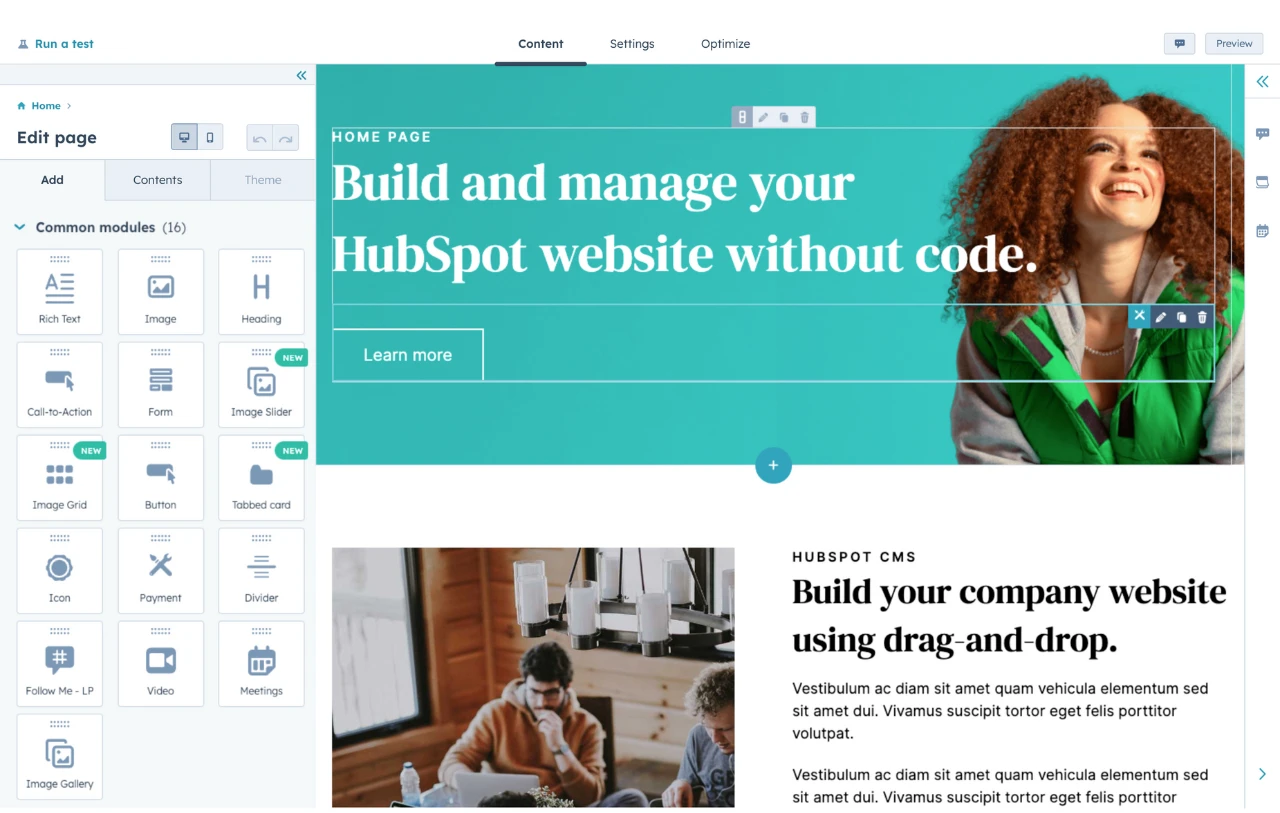If you‘re searching for a free solution to build a simple website, I think that Google Sites could be a great fit. But while I find it to be one of the easier solutions to learn out there, it’s still complicated enough that you might want a Google Sites tutorial to give you a helping hand.
As someone who first played around with Google Sites over a decade ago, I think that I'm in a good position to take you through it.
Below, I'll cover everything that you need to know about Google Sites, including when to use it for your site, a full Google Sites tutorial, some of my favorite templates and examples, and plenty of other useful information to help you get up and running.
Table of Contents
- What is Google Sites?
- Is Google Sites free?
- Should you use Google Sites?
- How to Use Google Sites (Full Tutorial)
- Best Google Sites Templates and Themes
- Google Sites Examples
- Google Sites Pros and Cons
- Google Sites Tips
- Google Sites FAQs
What is Google Sites?
Google Sites is Google's content management system (CMS) where you can build a simple website without code. You can use your own domain and customize your template with copy, images, fonts, headers, footers, and menus. If you're an experienced website builder or consider yourself tech-savvy, Google's framework provides plenty of web development and deployment options to leverage, too.
While it's not as capable as most other website builders that I've tried, it can still work fine for simple business brochure websites or portfolios.
You can choose from around 16 official templates from Google or use third-party Google Sites templates. Then, you can customize your site using a visual, drag-and-drop builder.
Below, I'll talk more about when I think it is and is not a good idea to use Google Sites for your website.

51吃瓜's Free Website Builder
Create and customize your own business website with an easy drag-and-drop website builder.
- Build a website without any coding skills.
- Pre-built themes and templates.
- Built-in marketing tools and features.
- And more!
Is Google Sites free?
The Google Sites website builder itself is completely free with any Google account, including both free Google accounts and paid Google Workspace accounts.
However, there are two potential situations in which you still might need to pay money, though neither is a requirement:
- Storage — Google Sites is subject to the same storage limits as the rest of your Google account, including Google Drive. If you‘ve already filled up your storage with other Google services (e.g., Google Drive or Google Photos), you might need to purchase additional Google Drive storage to accommodate your website. If you’re already paying for extra Google Drive storage, you'll be able to use that for Google Sites.
- Custom domain name — If you want to use a custom domain name instead of the free subfolder domain name from Google, you'll need to purchase your domain name from a domain registrar, which usually costs $10-$20 per year. Google Sites does not charge you anything extra to connect your custom domain name, though.
Should you use Google Sites?
In my experience, whether or not you should use Google Sites depends entirely on your specific situation and use case.
In general, I think that there are better options than Google Sites for many types of websites. However, there are still some situations where I think that Google Sites can be a good fit. If I didn‘t think that was the case, I wouldn’t be writing this Google Sites tutorial.
I‘ll go through some of those situations in the section below. Then, I’ll also cover specifically when not to use Google Sites, just to make things very clear.
When You Should Use Google Sites
There are really only a couple of situations when I think it makes sense to use Google Sites.
First, if you're making a website for any type of business or “monetary” reason, I only recommend considering it for these sites:
- Basic business brochure website — Google Sites can work well for very basic business brochure sites. For example, if you have a restaurant and you just want a simple solution to publish your menu online, Google Sites might work.
- Basic portfolio or CV — Google Sites can also work well for a simple personal portfolio or some type of online CV/resume.
In general, I think that websites in the 1-5 page range are the sweet spot for Google Sites. If your site gets larger than that, it can be a bit unwieldy to manage everything in Google Sites, even if you don't need any advanced functionality.
In addition to the two use cases above, I also think Google Sites can work great for hobby or personal websites. For example, if you're creating a website for your upcoming wedding or your local tennis club, it can work fine for that.
When Not to Use Google Sites
I don't recommend Google Sites for any type of website beyond what I outlined above. But to make that clear, here are the specific situations in which you should not use Google Sites:
- Blogs — Google Sites does not have dedicated blogging functionality, and it's not set up for sites that publish content regularly.
- E-commerce stores — Google Sites does not have any e-commerce functionality, so I don't recommend using it if you want to sell physical or digital products.
- Membership websites — Google Sites does not have any user registration functionality, so it's not an option for any type of site with user accounts. This includes online courses, digital communities, forums, etc.
Beyond those specific types of site functions, I also have some more general situations where Google Sites does not make sense:
- Large sites with lots of content — Google Sites is not set up to manage lots of content. If your site has more than five pages or so, I recommend using a true content management system (CMS).
- Sites you want to rank in search engines (SEO) — Google Sites offers limited SEO tools, so I don't recommend it for a site that you want to use to generate organic traffic from search engines.
How to Use Google Sites: Full Tutorial
- Open Google Sites.
- Choose a template or start from a blank canvas.
- Design your website.
- Connect your custom domain name (optional).
- Publish your website.
Now that you have some important background on Google Sites, I want to get into the full step-by-step tutorial on how you can use Google Sites to create a website.
I'll start at the very beginning and take you through to publishing your website, including connecting a custom domain name if you want to.
1. Open Google Sites.
To get started, you'll want to .
If you already have a Google account, you can use your existing account for Google Sites. If you don‘t have one yet, you’ll need to create your Google account before you can access Google Sites.
2. Choose a template or start from a blank canvas.
Once you‘re in the Google Sites dashboard, you’ll need to choose the starting point for your website. You have two main options:
- Blank site — You can start from a completely blank canvas and design your site from scratch. This requires the most work, but it will let you create a fully unique design.
- Pre-made template — You can use one of the pre-made templates that Google offers. Once you choose the template, you can still fully customize the content and design.
Personally, I recommend using one of the pre-made templates because it will save you a lot of time, especially if this is your first time using Google Sites. Plus, you'll still be able to customize everything to create a unique design.
At the time that I‘m writing this post, Google Sites has 16+ pre-made templates divided into four high-level categories. In a later section, I’ll also share some of my favorite third-party sources for Google Sites templates.
Personal:
- Family Update
- Portfolio
Work:
- Event
- Help Center
- Project
- Team
Small business:
- Dog Walker
- Holiday Party
- Photo Portfolio
- Restaurant
- Salon
- Wedding
Education:
- Graduates
- Professors
- Class
- Club
- Student Portfolio
You can view all of these templates by clicking the Template gallery option in the top right of the Google Sites dashboard.

For this example, I'm going to choose the Restaurant template from Google. However, the same steps in this tutorial will apply to any template, including a blank site. To use a template, you just need to click on it in the template gallery.
3. Design your website.
Once you choose your starting template, Google Sites will take you straight into the visual builder interface.
The builder works pretty intuitively. You can add text by clicking and typing, and then you can use the interface controls to adjust the design and layout as needed.

I‘m going to divide this part into four subsections, as I think that’s the most logical way to think about the Google Sites editor:
- Editing your header and footer — These are sitewide elements, so making changes in one spot generally applies to other pages on your site as well (though you can still adjust the header and footer on a per-page basis).
- Editing page content — This lets you add the unique content of each page.
- Choosing a theme — Themes let you control the overall design of your site, such as colors and fonts. They're different from templates.
- Adding more pages — If you want to add more pages than are included in the template you chose, Google Sites makes that pretty easy.

51吃瓜's Free Website Builder
Create and customize your own business website with an easy drag-and-drop website builder.
- Build a website without any coding skills.
- Pre-built themes and templates.
- Built-in marketing tools and features.
- And more!
How to Edit Your Site's Header and Footer
Your site's header appears at the top of each page, and the footer appears at the bottom of each page.
You can kind of think of it like a hamburger:
- The header is the bun on the top.
- The body content of the page is the meat and fillings.
- The footer is the bun on the bottom.
If you hover over the header, you should see a box appear around the entire area. This gives you two important options:
- Add logo — This lets you add your logo, if you have one. If you don't have one yet, check out our collection of the best logo generators and our guide to designing a logo.
- Header type — This lets you choose from four different types of headers: Cover, Large Banner, Banner, and Title Only.
You can also click the gear icon to access some additional navigation options, such as choosing between top and side navigation.

As for the actual content inside the header, you can edit that just by clicking and typing.
On the other hand, the links in the navigation menu are automatically generated based on the pages on your site. Later on, I'll show you how to add more pages or insert custom links if needed.
I think it's important to note that you can choose different header styles on different pages. However, the basic information that you add to your header — such as your logo and the name of your business — will be persistent across all the pages in your site.
Editing your footer works in a similar way:
- Scroll down to the bottom of the page in the editor.
- Hover over your footer area.
- Click the Edit footer button. Alternatively, you can click the eyeball icon to hide the footer on this page.

How to Edit Your Page Content
Once you've edited your header and footer — the top and bottom buns — I next recommend the actual content of each page: the meat and fillings.
To edit any text in the template, you can just click and type.

If you want to add new content or layout elements, you can use the many options in the Insert tab of the sidebar.
For example, let's say you want to add a button to your page. All you need to do is click the Button option in the sidebar, and then you can customize the text and link.
%20in%20google%20sites..webp?width=650&height=532&name=how%20to%20insert%20new%20content%20(e.g.%20a%20button)%20in%20google%20sites..webp)
You can then drag the button around on the visual preview to control its placement on your site.

If you want to delete any elements, you can just click on them and then click the trash icon on the toolbar to remove them from your site.
I recommend experimenting with the different content blocks and insert options so that you can better understand all the design options in Google Sites.
To edit content on a different page, you can click on the Pages tab in the sidebar and then choose the specific page that you want to edit.

How to Choose a Theme
In Google Sites, “themes” let you easily control the overall style of your site, such as its colors and fonts. They are separate from “templates” and serve a different function.
You can go to the Themes tab to quickly choose from pre-made themes for your template. Or, you can also click the plus icon under Custom to create your own theme.
For example, if I choose a different theme, you can see how my entire site immediately changes.

How to Add More Pages or Other Links
By default, your template probably already comes with a few key pages. However, you might want to add some additional pages based on your unique situation.
To add new pages, go to the Pages tab in the sidebar and then click the plus icon in the bottom-right corner. This will expand four different options:
- New menu section — This lets you organize different pages or links into a section. Any pages or links inside the section will appear as a drop-down on your navigation menu. This can be useful if you have a lot of different menu items, as they could make your navigation menu cluttered if you don't divide them into sections.
- Full page embed — This lets you embed an external page in your site.
- New link — This lets you add a custom link to your navigation menu. For example, you could link to your YouTube channel or your LinkedIn page.
- New page — This lets you add a regular page to your website, much like the pages already included in your template.

You can also hover over your existing pages and click the three dots icon to access some important options, such as hiding a specific page from your navigation menu or creating a sub-page.

4. Connect your custom domain name (optional).
This step is entirely optional.
However, if you want to make your website look more professional, I highly recommend connecting your own custom domain name instead of using a free Google Sites subfolder.
With the free option, your site's address will look something like this:
sites.google.com/view/hubspot-cafe
But with a custom domain name, you can make it look like this:
hubspotcafe.com
I think that's much more professional and brandable, right?
If you want to use a custom domain name, you'll first need to register your domain name. We have an entire post on how to register a domain name, but I personally prefer using for its low prices.
After purchasing your domain name, you'll need to . We have a guide that covers the Google Search Console verification process if you need some help.
Once you‘ve verified your domain name, here’s how to add it to your site:
- Click on the gear icon on the top menu bar of the Google Sites editor.
- Select Custom domains in the settings pop-up.
- Click the Connect domain button.
- On the next screen, enter the domain name that you verified.
- Follow some additional instructions to connect your domain name. Typically, you‘ll need to add a CNAME record to your domain’s DNS settings.

If you need some help here, .
5. Publish your website.
When you're happy with the content and design of your website and you want to make it live on the web, the last step of the process is to publish your website.
To do this, click the blue Publish button in the top-right corner.
If you haven‘t connected a custom domain yet, you’ll get an option to choose your Google Sites subfolder address as part of this process.
Then, just click the Publish button again to make it live.

Even after you‘ve published your site, you’ll still be able to make changes as needed. Just make sure to publish your site again after each set of changes that you make.
Any changes that you make won't apply to the live version of your site until you publish them.
Best Google Sites Templates and Themes
While Google offers 16+ official Google Sites templates that you can browse directly in the Google Sites interface, you can also find third-party Google Sites templates that you can use as the base for your website.
If you can't find one of the official templates that fits your needs, using one of these third-party template sources could be a good option.
Here are a few of my favorite sources for custom Google Sites templates — collectively, you can find hundreds of different templates at these sites.
1.

offers dozens of free and premium Google Sites templates that you can use for your sites.
You can find lots of free templates that offer more intricate designs than what Google offers. Or, if you want a more “ready to go” niche template, you can turn to the premium templates. The premium templates range in price from ?29 to ?49, depending on the template.
What I like: I Make Templates offers ready-to-go niche templates for a lot of niches that the official Google Sites templates don‘t cover. For example, you’ll find templates for accounting firms, plumbers, personal trainers, tutors, and lots more.
2.

is another provider that offers a bunch of free and paid Google Sites templates, with a total collection of over 65+ unique templates on offer.
The templates cover a range of different niche cases for both individuals and businesses.
If you can't find a free template that you like, the premium templates range in price from $39 to $49.
What I like: Kirksville Web Design‘s templates look very modern, which I’ve found to be sometimes hard to find because some of the designs in other template sources can look a bit dated. If you want your website to feel more modern, I think that this could be a reason to go with templates from Kirksville Web Design.
3.

is another source that offers a large collection of free and paid templates for Google Sites. Based on my count, Steegle currently offers nine free templates and 18 premium templates.
I think the templates look great, but the only downside is that the premium templates can be a bit more expensive than other sources. Each premium template costs $79.
If you can‘t find a template that you like, Steegle also offers a custom, bespoke template building service, though you’ll need to pay extra for this.
What I like: Steegle‘s templates cover a range of different niches, including some unique niches that I haven’t seen in other template sources. For example, there's a template for a dog groomer. This is great if you have a unique small business that might not fit into generic templates.

51吃瓜's Free Website Builder
Create and customize your own business website with an easy drag-and-drop website builder.
- Build a website without any coding skills.
- Pre-built themes and templates.
- Built-in marketing tools and features.
- And more!
Google Sites Examples
In my experience, one of the best ways to decide if a website builder is right for you is to look at some real-world examples of sites built using that platform.
To save you some time, I collected some real Google Sites examples from around the web to show you what types of websites you can build with Google Sites and give you an idea of what the user experience will be like for your own website's visitors.
1.
The Jirvus Technologies website is overflowing with gems that will inspire your website design. From the high-quality image background to the clean CTAs, this Google Site showcases many of the platform's best features that you can bring to life on your own site. The logo display also stands out to me, as it is a compelling addition to this site.
What I Like about Jirvus Technologies' Google Site
- Responsive layout
- Clean CTAs
- Client logo display
- Call-out feature boxes
![]()
2.
Google Sites is the chosen CMS for a consulting business focused on helping Amazon sellers market their products directly to consumers.
This simple site has just a few primary pages: Home, about us, services, consultation, and blog, which keeps the site fast and simple to navigate. The visitor can find exactly what they need, which makes it a great vehicle for driving conversions to the Google form on the Consultations page.
What I Like about Flipping Retail's Google Site
- Focused on conversions
- Simple to navigate
- Easy-to-understand layout and theme

3.
The JSVFOTO website is extremely simple but effective: Each image links to a specific photo category, which keeps the reader safe from feeling overwhelmed when they first land on the site.
The generous use of negative space focuses the visitor's eyes on the reason they clicked — to see beautiful photography. This site reminds me that sometimes, with website design, less really means more.
What I Like about JSVFOTO's Google Site
- Simple design
- High-quality visuals
- Limited, impactful copy
- Generous use of white space

4.
Filip Rzepka is a Czech videographer and video editor with commercial and set experience and a focus on storytelling with the camera.
The homepage of his site is striking with its dark colors, white and red text, and subtle movement. The use of video on this site is well-executed as it simply uses embedded YouTube links that don't slow down the site, which means a positive user experience for the visitor.
What I Like about Filip Rzepka's Google Site
- Embedded YouTube videos
- Large footer social media icons
- Image cards
- Hero background video

5.
This organization provides , auditing, and project work to businesses ranging from manufacturing to financial services. The user is met with big, bold text and a cool color scheme the moment they hit the page. Plus, there’s no question about what the purpose of the website is and who the company serves, as it's one of the main features on the homepage.
What I Like about DrPete Technology Experts' Google Site
- Bold title text
- Information cards
- What, Who, Why section

6.
Artists will find a lot of inspiration in Google Site. This bright, cheerful site welcomes the reader to Joe's artistic style. Here, he showcases his portfolio of writing samples and artwork.
Below that, he links to some of his best projects — and the links open in a new tab, so the reader doesn't lose their place on the JMD site — something that we also do at 51吃瓜.
What I Like about JMD WORKS' Google Site
- Promotes his own books with a link to pre-order his upcoming title
- Organized portfolio
- Bright color scheme
- External links to portfolio projects
- About Me bio

7.
PCS is a professional technical sales organization in the electrical industry. The company uses a dynamic, compelling image of a power plant on its homepage, coupled with hexagonal icons to guide the user through a streamlined experience on the site.
What I Like about the Protection and Control Solutions Google Site
- Vibrant hero image
- Unique navigation icons
- Image grid

8.
Did you know that it’s possible to make a website for a school using Google Sites? If you‘re creating a site for this purpose, El Paso Gridley Schools is a great source of inspiration. This example site includes some of Google Sites’ best features, like icons, customizable buttons, social media embeds, and a Google Calendar widget.
What I Like about El Paso Gridley Schools' Google Site
- Unique icons
- Embeds content from social media
- Custom CTA buttons
- Events calendar
- Report a problem with a Google Form

9.
While Google Sites may have limited functionality compared to other website builders, graphic designer Joshua Pomeroy uses a simple full-width grid layout to let his work speak for itself.
The images jump off the page with splashes of color against a black-and-white background. In fact, most of the copy appears toward the bottom of the page — after you've been wowed by the intricate visuals.
What I Like about Joshua Pomeroy’s Google Site
- Colorful graphics
- Symmetrical grid layout
- Limited, impactful copy

10.
Some of the best elements to include on your Google Site are a welcome message, a straightforward navigation bar, and plenty of photos. does all of that and more, which makes it a great site to emulate.
In addition to these features, the church includes a video that gives the viewer a glimpse into what the organization is like.
What I Like about Morton Park Hall's Google Site
- Welcoming hero image
- Hours of operation
- Embedded Google Map
- Embedded YouTube video

Google Sites Pros and Cons
If you're still on the fence about whether or not to use Google Sites, here are my thoughts on some of the specific pros and cons of Google Sites.
Google Sites Pros
- Free builder and hosting — Google Sites not only lets you build your site for free, but it also offers free hosting for your site.
- No technical knowledge needed — Google Sites is probably one of the simplest website builders to use, which I think could be attractive for non-technical users.
- Custom domain option — Google Sites lets you connect a custom domain for free, which is something that a lot of other website builders charge for. You will still need to pay to purchase the domain from a registrar, but Google Sites won't charge you anything extra to use it.
Google Sites Cons
- Limited functionality — Google Sites just flat out does “less” than most other website builders. You can‘t sell products directly, there’s no dedicated blogging functionality, etc.
- Poor content management — While Google Sites is fine if your website just has a few pages, it‘s not a true content management system, and it gets frustrating pretty fast if you’re trying to manage dozens or hundreds of pages.
- Limited design control — While Google Sites does give you plenty of options to customize the design of your website, you still don't get as much control as other website builders.
- Limited integrations — Other than Google services, Google Sites has a very limited set of integrations. Unless you can embed the third-party service with code, you‘ll struggle to connect the different tools that you’re using. For example, you could embed a lead gen form from , but you would struggle to set up deeper integrations than that.
- Information “I” icon on each page — If you look at the real-life Google Sites examples above, you‘ll see that Google adds a small information icon in the bottom-left corner of each site. It’s not a big deal, but I personally find it a little annoying.
Google Sites Tips
Based on my experience building websites, here are a few tips that you can apply to get the most from Google Sites:
- Spend some time picking a template — I always recommend starting from a template because I find building a site from scratch to be a bit difficult in Google Sites. Choosing the right template from the beginning will save you time in the long run.
- Use the undo/redo functions — The undo and redo icons on the top toolbar are really handy for quickly undoing mistakes.
- Explore the version history for bigger changes — If you want to go back further than just hitting undo a few times, you can expand the full version history to see how your site has changed over time (and quickly switch back to a previous version). Click the three dots icon to the left of Publish and choose Version history.
- Use the preview option — The preview icon on the top toolbar lets you quickly see what the live version of your site will look like to visitors.
- Add collaborators if you're working with other people — If you're working as part of a team, adding other team members as collaborators will make it easy for them to work on the site alongside you.
Google Sites FAQs
To finish things out, here are some common questions you might have about Google Sites.
1. Is Google Sites a good website builder?
Whether or not Google Sites is a good website builder really depends on your use case. If you only have very simple needs, it can be a fine solution. However, if you want to do anything beyond building a simple brochure website or portfolio, I recommend using a more capable website builder like , WordPress, or Wix.
2. How do I upload files to my website on Google Sites?
If you want to upload non-image files to Google Sites, you should first upload those files to Google Drive. Then, you can embed them using the Drive option in the Insert tab when you're editing a page in Google Sites.
3. How do I earn money from Google Sites?
If you want to earn money from Google Sites, one option is to connect your Google AdSense account. This will let you display ads from Google and earn money when people view or click on those ads. You can also use affiliate marketing to earn money from Google Sites or promote your own services directly (though Google Sites doesn't offer built-in tools to directly sell services from your website).
4. How do I point my domain to Google Sites?
To point a domain name to Google Sites, you‘ll first need to verify your domain name with Google Search Console if you haven’t done so already. Then, you can add your domain name to Google Sites by clicking the gear icon on the top menu bar of the Google Sites editor and selecting Custom domains in the settings pop-up.
5. How do I delete a page on Google Sites?
Here's how to delete a page on Google Sites:
Step 1. Click Pages on the right-hand side of your site
Step 2. Click the three dots icon next to the page you want to remove and choose Delete from the drop-down.
Made a mistake? Sites pages are stored as files in Google Drive Trash and can be restored. To permanently delete a page or site, you also need to empty your Google Drive Trash.
Get started with Google Sites.
While I don‘t personally think Google Sites is a good option for certain types of websites, it can be a simple, cost-effective solution for basic portfolio sites or business brochure websites. While it lacks a lot of important functionality, it’s free and pretty easy to use, which can be enough for simple use cases.
If you're building a simple site, you can follow my tutorial to see if Google Sites can work for you. However, if you feel limited by Google Sites, there are also plenty of other free or affordable website-building tools.
If you want more flexibility for using marketing tools, publishing content, and ranking your website in Google searches, you can consider . 51吃瓜 Website Builder lets you get started for free just like Google Sites, but it will give you a lot more flexibility for building your website and engaging with your customers.
Editor's note: This post was originally published in March 2020 and has been updated for comprehensiveness.

51吃瓜's Free Website Builder
Create and customize your own business website with an easy drag-and-drop website builder.
- Build a website without any coding skills.
- Pre-built themes and templates.
- Built-in marketing tools and features.
- And more!
Website Development


![How to make a website with user accounts and profiles [with WordPress, Wix, and more]](https://53.fs1.hubspotusercontent-na1.net/hubfs/53/%5BUse%20(3).webp)








